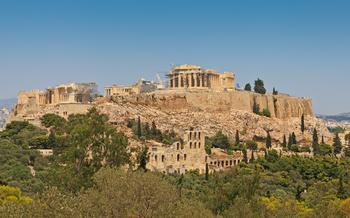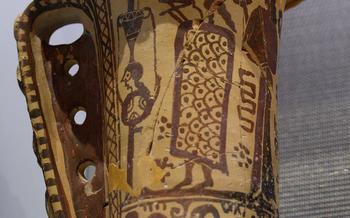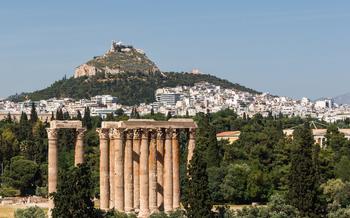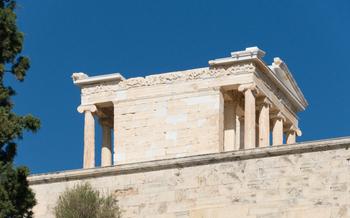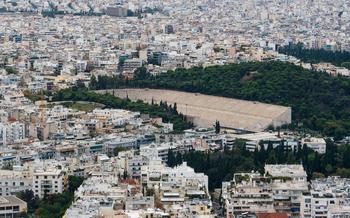
Olympieion
- The Olympieion: A Monumental Tribute to Zeus
- Hours of Operation and Admission Fees
- Exploring the Temple Grounds
- Historical Context and Significance
- Architectural Marvels
- The Statue of Zeus
- Myths and Legends
- Tips for a Memorable Visit
- Events and Exhibitions
- Nearby Attractions
- Local Cuisine and Dining Options
- Souvenirs and Shopping
The Olympieion: A Monumental Tribute to Zeus
The Olympieion, or Temple of Olympian Zeus, stands as a testament to the grandeur and devotion of ancient Athens. Erected in honor of the almighty Zeus, the king of the Greek gods, this colossal temple was a marvel of architectural prowess and religious significance. Its construction spanned several centuries, beginning in the 6th century BC and finally completed by the Roman emperor Hadrian in the 2nd century AD.
The Olympieion's sheer size and magnificence were awe-inspiring. It boasted a rectangular layout measuring 135 meters in length and 68 meters in width, dwarfing other temples in the city. Its exterior was adorned with 104 massive Corinthian columns, each towering over 17 meters tall, creating an imposing facade that commanded attention from afar. Inside the temple, a colossal statue of Zeus, crafted from gold and ivory, was enshrined, further emphasizing the deity's power and majesty.
Beyond its architectural splendor, the Olympieion held deep religious significance for the ancient Athenians. It served as a sanctuary dedicated to Zeus, where grand festivals and ceremonies were held in his honor. The temple was a focal point of the Panathenaic Festival, a major religious and cultural event that celebrated the city's patron goddess, Athena. During these festivals, processions and sacrifices took place within the temple's sacred precincts, honoring Zeus and seeking his blessings for the city and its people.
Hours of Operation and Admission Fees
The Olympieion is open to the public daily, offering visitors the chance to explore its grandeur and significance. The current opening hours are from 8:00 AM to 3:00 PM during the winter months (November to March) and 8:00 AM to 8:00 PM during the summer months (April to October).
To experience the wonders of the Olympieion, visitors can purchase tickets at the site's entrance. Regular admission fees apply, with discounted rates available for students, seniors, and groups. It's worth noting that the Olympieion offers free entrance on certain days and during specific hours, allowing budget-conscious travelers to enjoy its wonders without any admission costs.
Additionally, guided tours are available for those seeking a more in-depth understanding of the temple's history, architecture, and significance. These tours, led by knowledgeable guides, provide valuable insights and anecdotes, enhancing the overall experience for visitors.
Exploring the Temple Grounds
The Olympieion complex offers a captivating experience that transports visitors back in time. As you approach the temple, its sheer size and grandeur command attention. The surrounding archaeological park provides a serene setting, allowing you to immerse yourself in the ancient atmosphere. Take a moment to appreciate the temple's layout, with its impressive rows of columns and well-preserved pediments.
Don't miss the opportunity to climb the steps leading to the temple's platform. From this vantage point, you'll be rewarded with breathtaking views of the Acropolis and the surrounding hills. Capture the iconic image of the Parthenon framed by the columns of the Olympieion, a sight that will leave an unforgettable impression.
Take your time to explore the temple's exterior, admiring the intricate carvings and sculptures that adorn the frieze and pediments. Each detail tells a story, offering a glimpse into Greek mythology and religious beliefs.
The Olympieion is a photographer's paradise, providing endless opportunities for capturing stunning shots. Experiment with different angles and perspectives to showcase the temple's grandeur and the surrounding landscape. Whether you're a professional photographer or simply enjoy capturing memories, you'll find ample inspiration at this remarkable site.
Historical Context and Significance
The Olympieion holds immense historical significance as a testament to ancient Athens' religious devotion and architectural prowess. Dedicated to the almighty Zeus, the temple played a pivotal role in the city's religious ceremonies and festivals. It was here that the Athenians honored Zeus, the king of the gods, with grand offerings and processions. The construction of the Olympieion spanned several centuries, beginning in the 6th century BC and finally completed by the Roman emperor Hadrian in the 2nd century AD. This protracted timeline reflects the temple's importance and the challenges faced in its construction. The Olympieion served as a symbol of Athens' wealth, power, and cultural achievements, reinforcing the city's status as a prominent center of ancient Greek civilization.
Architectural Marvels
The Olympieion's design showcases several unique features that set it apart from other ancient Greek temples. Its most striking characteristic is its colossal size, with a footprint that measures approximately 135 meters (443 feet) in length and 64 meters (210 feet) in width. The temple's grandeur is further emphasized by its massive Corinthian columns, which stand at an impressive height of 17 meters (56 feet). These columns, with their intricate capitals adorned with acanthus leaves, are a testament to the architectural prowess of the ancient Greeks.
In addition to its size and columns, the Olympieion features several other notable architectural elements. The temple's pediments, or triangular gables above the colonnade, were adorned with elaborate sculptures depicting scenes from Greek mythology. Although these sculptures have been lost over time, their empty niches still hint at the grandeur of the original design.
Overall, the Olympieion is a testament to the ingenuity and artistic skill of the ancient Greeks. Its unique architectural features, combined with its sheer size and scale, make it one of the most impressive and iconic landmarks in Athens.
The Statue of Zeus
The Olympieion was home to a colossal statue of Zeus, the king of the gods in Greek mythology. Crafted from ivory and gold by the renowned sculptor Phidias, the statue stood an awe-inspiring 40 feet (12 meters) tall, making it one of the largest and most impressive sculptures of the ancient world. Phidias' exceptional artistry and attention to detail brought Zeus to life, capturing the god's majesty, power, and divine presence.
The statue depicted Zeus seated on a magnificent throne, adorned with intricate carvings and precious stones. His muscular physique exuded strength and authority, while his serene expression conveyed wisdom and benevolence. In his left hand, Zeus held a scepter topped with an eagle, symbolizing his dominion over the heavens. His right hand, extended forward, once held a statue of Nike, the goddess of victory, further emphasizing his supreme power.
The statue's construction involved a complex technique known as chryselephantine, combining ivory for the exposed flesh and gold for the drapery and other details. The ivory was carefully carved into thin sheets and attached to a wooden framework, while the gold was hammered into thin plates and applied to the surface. The statue's eyes were made of precious stones, adding to its lifelike appearance.
Unfortunately, the statue did not survive the ravages of time. It was eventually dismantled and removed from the temple, likely during the 5th century AD, and its fate remains a mystery. Historians believe it may have been destroyed in a fire or melted down for its valuable materials. Despite its loss, the statue of Zeus at the Olympieion remains one of the most iconic and awe-inspiring works of ancient Greek art, forever immortalized in descriptions and depictions from antiquity.
Myths and Legends
The Olympieion is steeped in a rich tapestry of myths and legends, serving as a stage for divine narratives and epic tales. At the heart of these stories lies the myth of Zeus, the king of the gods, whose birth and rise to power are intertwined with the temple's origins. According to legend, Zeus was born in a cave on Mount Ida in Crete, where he was raised by the goat-like nymph Amalthea. To protect him from his father Cronus, who devoured his children, Zeus was hidden away and fed on the milk of Amalthea and honey from wild bees.
As Zeus grew in strength and cunning, he eventually challenged Cronus and forced him to disgorge his siblings. Together, they formed a powerful alliance, overthrowing Cronus and establishing Zeus as the ruler of the gods on Mount Olympus. In honor of his victory, Zeus is said to have chosen Athens as his earthly home and commanded the construction of a grand temple to symbolize his majesty.
The Olympieion also figures prominently in other Greek myths and legends. It is said that the temple housed a sacred olive tree, planted by the goddess Athena, which was a symbol of the city's prosperity and power. The temple was also associated with the Olympic Games, which were held in honor of Zeus every four years at Olympia. During these games, athletes from all over Greece would compete in various sports, seeking glory and the favor of the gods.
These myths and legends continue to captivate and inspire visitors to the Olympieion, providing a glimpse into the rich storytelling tradition of ancient Greece. They serve as a reminder of the enduring power of mythology and its ability to shape our understanding of history, culture, and the human experience.
Tips for a Memorable Visit
Timing is Everything:
- Aim for early morning or late afternoon visits to avoid the midday heat and crowds.
- The golden hour (just after sunrise or before sunset) offers beautiful lighting for photography.
- Plan your visit around major events or festivals in Athens to experience special openings or cultural performances.
Combine and Conquer:
- Take advantage of the Olympieion's proximity to other attractions and plan a combined itinerary.
- Visit the Acropolis and Parthenon, Hadrian's Arch, or the National Archaeological Museum on the same day.
- Purchase a combined ticket for multiple attractions to save money and time.
Guided Tours and Audio Guides:
- Guided tours provide in-depth historical context and insights into the Olympieion.
- Audio guides offer a self-paced tour with informative commentary.
- Consider joining a mythology-themed tour to delve deeper into Greek myths and legends.
Facilities and Amenities:
- The Olympieion complex offers restrooms, a small café, and a gift shop.
- Stay hydrated by bringing water, especially during the summer months.
- Wear comfortable shoes as the site involves some walking on uneven terrain.
Events and Exhibitions
The Olympieion occasionally hosts events and exhibitions that bring the ancient temple to life. These events may include:
-
Cultural Performances: Ancient Greek plays, concerts, or traditional dance performances are sometimes held within the temple grounds, creating a unique and immersive experience.
-
Educational Programs: Workshops, lectures, or guided tours focusing on the history, mythology, and architecture of the Olympieion are offered periodically for those seeking a deeper understanding of the site.
-
Special Openings: During festivals or special occasions, the Olympieion may extend its opening hours or offer free admission to encourage more visitors to explore this iconic landmark.
-
Exhibitions: Temporary exhibitions showcasing artifacts, historical documents, or art related to the Olympieion and ancient Greek culture may be organized within the temple or nearby venues.
To make the most of your visit, check for upcoming events and exhibitions before your trip to enhance your experience and gain a deeper appreciation for the Olympieion's cultural significance.
Nearby Attractions
In the vicinity of the Olympieion, you can delve further into Athens' rich history and cultural heritage by visiting other significant ancient sites and museums. A short stroll away, the Acropolis, crowned by the iconic Parthenon, stands as a testament to ancient Greek architectural prowess and is a must-see for any visitor. The Acropolis Museum, located at the foot of the hill, houses a vast collection of artifacts and sculptures from the Acropolis, providing insights into the grandeur of ancient Athens.
Just a stone's throw from the Olympieion, Hadrian's Arch, an imposing gateway built by Emperor Hadrian in the 2nd century AD, marks the entrance to the ancient city. Nearby, the Temple of Olympian Zeus, a smaller but equally impressive temple dedicated to the king of the gods, offers a glimpse into the religious practices of ancient Athenians.
For a comprehensive exploration of Greece's archaeological treasures, the National Archaeological Museum, a short walk from the Olympieion, is a must-visit. This world-renowned museum houses an extensive collection of artifacts from across the country, including sculptures, pottery, jewelry, and other relics that showcase the artistic and cultural achievements of ancient Greek civilization.
Local Cuisine and Dining Options
In the vicinity of the Olympieion, visitors can immerse themselves in the culinary delights of Athens. A plethora of traditional Greek tavernas and restaurants line the streets, offering a symphony of flavors and aromas. These establishments serve an array of delectable dishes, ranging from classic moussaka and souvlaki to fresh seafood and mouthwatering pastries.
For a quick bite or a refreshing break, numerous cafés and bakeries are scattered around the area. Indulge in a flaky spanakopita, a savory cheese pie, or satisfy your sweet cravings with traditional loukoumades, honey-dipped doughnuts.
Street food enthusiasts will find an array of tempting options, including grilled meats, crispy fries, and koulouri, a sesame-crusted bread ring. These portable snacks provide a delightful way to sample local flavors while exploring the neighborhood.
To enhance your culinary journey, seek recommendations from locals or consult online reviews to discover hidden gems and off-the-beaten-path eateries. Embrace the opportunity to savor authentic Greek cuisine and immerse yourself in the vibrant food culture of Athens.
Souvenirs and Shopping
For those who wish to remember their visit to the Olympieion with a tangible memento, there are several gift shops and souvenir stalls located in the vicinity of the temple. These shops offer a wide range of items inspired by the ancient site, including replicas of coins, pottery, and sculptures. Visitors can also find unique handicrafts and handmade products, such as jewelry, leather goods, and textiles, which showcase the vibrant artistic traditions of Greece.
When shopping for souvenirs, it's worth taking the time to explore the local markets and bazaars. These bustling marketplaces offer a more authentic experience and often have a wider selection of goods at competitive prices. Bargaining is a common practice in Greece, so don't be afraid to negotiate for a better deal. With a little patience and charm, you can find one-of-a-kind treasures that will serve as lasting reminders of your journey to the Olympieion.

